The AMD Ryzen 9 3950X Review: 16 Cores on 7nm with PCIe 4.0
by Dr. Ian Cutress on November 14, 2019 9:00 AM ESTGaming: Far Cry 5
The latest title in Ubisoft's Far Cry series lands us right into the unwelcoming arms of an armed militant cult in Montana, one of the many middles-of-nowhere in the United States. With a charismatic and enigmatic adversary, gorgeous landscapes of the northwestern American flavor, and lots of violence, it is classic Far Cry fare. Graphically intensive in an open-world environment, the game mixes in action and exploration.
Far Cry 5 does support Vega-centric features with Rapid Packed Math and Shader Intrinsics. Far Cry 5 also supports HDR (HDR10, scRGB, and FreeSync 2). We use the in-game benchmark for our data, and report the average/minimum frame rates.
All of our benchmark results can also be found in our benchmark engine, Bench.
| AnandTech | IGP | Low | Medium | High |
| Average FPS |  |
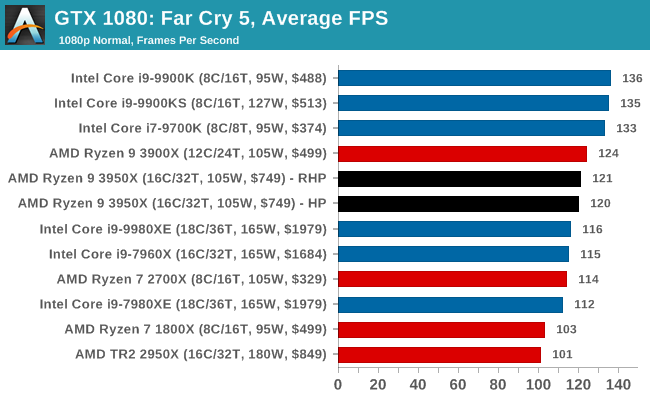 |
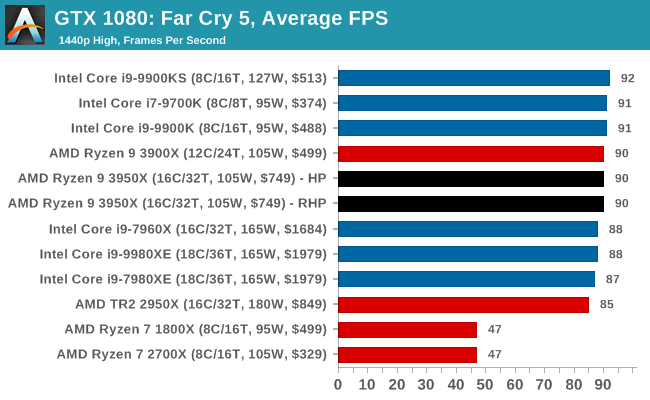 |
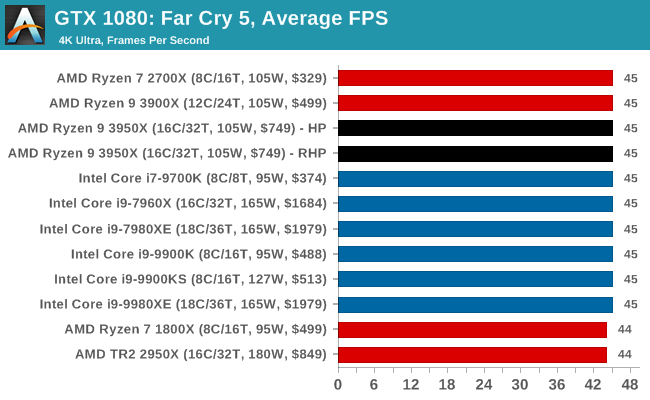 |
| 95th Percentile | 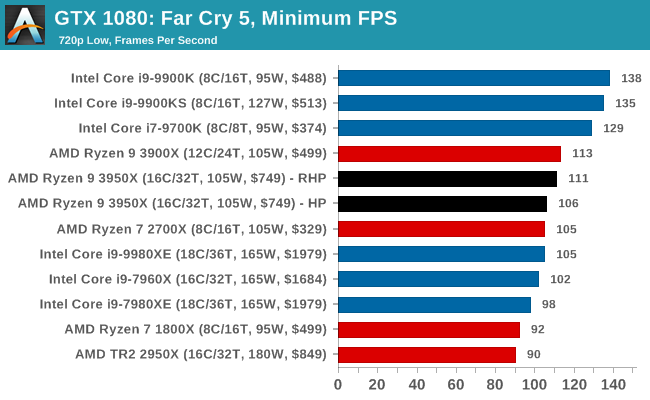 |
 |
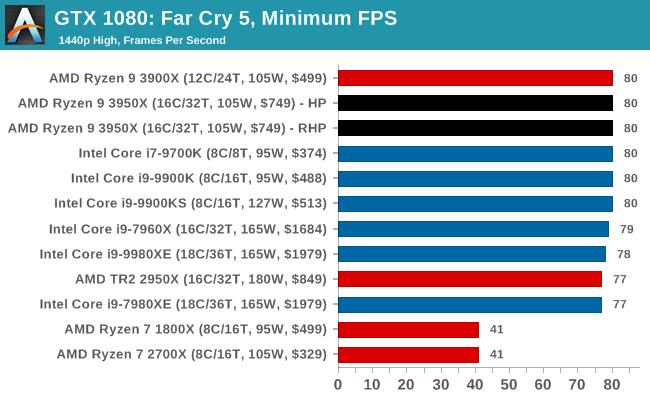 |
 |












206 Comments
View All Comments
Spunjji - Thursday, November 14, 2019 - link
In theory it might be. In practice, they're still only able to make mobile CPUs with 4 cores or less on it.Orange_Swan - Thursday, November 14, 2019 - link
Nah, they've got at least one 6core/12thread, 15/25w mobile CPU, the Core i7-10710URetycint - Thursday, November 14, 2019 - link
That's 14nm. All Intel's 10nm processors so far have been limited to 4 core Ice Lake U processorsSmartcom5 - Friday, November 15, 2019 - link
If, and that's the whole issue here since a while now, IF Intel's 10nm would be working after all.Sure enough, that's a requirement which still needs to be fulfilled yet. The best process – no matter how oh so advanced it is going to be (on paper) – is worth exactly no·thing if it ain't working. Then, even a (on paper inferior) node is superior, since it at least meets a crucial condition; It's working (already).Thus, it isn't anymore. They relaxed it quite a bit in 2017 to make it work, that's it.
Intel's actual 10nm which spawned Ice Lake isn't the same as it was before, that's why it's coined 10nm+. It's actually less dense than Intel's initial and original-10nm which brought Cannonlake – density was toned down, it's more like ~12nm now.
Interestingly TSMC on its current 7nm N7-process already archives virtually the very same density Intel failed to archive on their initial 10nm-process back then – while their current 10nm+, which has a toned-down density from initially 2.7× down to only some 2.0—2.2× (depending on what sources you're willing to trust), is rumoured to rather equal some 12nm-ish alike process instead of being closer to any initial Intel'ian 10nm.
So while Intel somehow failed, others archived the same density-goals Intel was trying to do for years, to no greater avail – and those others where even on track as scheduled most of the time. Thus, TSMC already fabs on a process which would equal Intel's very initial 10nm-process, which never really saw any greater light of day, bar that known i3-8121U (well, and that m3-8114Y of course, ... you don't know a thing about it, okay?).
GraveNoX - Thursday, November 14, 2019 - link
Yes, they will launch 10nm and 7nm on the same day so you have the freedom to choose which version of the chip you want.Oliseo - Thursday, November 14, 2019 - link
"Based on my imagination Intel will destroy AMD"Santoval - Thursday, November 14, 2019 - link
It is meaningless to compare Intel's 7nm parts, which will be released in 2021 assuming NO delays (thus more realistically in 2022+) with AMD's current 7nm parts. If you were going for a "node for node" comparison that is even more meaningless, because Intel's 7nm node will be equivalent to TSMC's 4nm or 5nm node in transistor density (I have read numbers predicting ~185 million transistors per mm^2 for TSMC's 5nm node and ~200nm MTr/mm^2 for Intel's 7nm node). TSMC's 5nm node will almost certainly be released before Intel's 7nm node by the way.Regarding Intel's 10nm node parts, while Sunny Cove appears to have a higher IPC than Zen 2 Intel's 10nm parts suffer from much lower clocks which have eaten away all or almost all the IPC gains. This is why Intel have not announced an Ice Lake-S/H release and intend to replace it with Comet Lake-S/H. S/H parts require high clocks, which cannot be provided by Intel's 10nm+ node due to very low yields at high clocks. Only low power Ice Lake-U/Y parts and Ice Lake Xeons will be released. Why? Because these parts have lower clocks.
More or less the same thing might be repeated with Tiger Lake, in 2H 2020, which would mean that Intel are not very confident of fixing their 10nm node issues even with their 10nm++ node variant. It is rumored that there will be no Tiger Lake-S/H parts and Rocket Lake-S/H will take their place. What's Rocket Lake? A 14nm+++++++ part but with a new μarch (Sunny or Willow Cove cores and a Gen11 or Gen12 iGPU).
Santoval - Thursday, November 14, 2019 - link
edit : "and ~200 MTr/mm^2 for Intel's 7nm node".Targon - Thursday, November 14, 2019 - link
Didn't TSMC start 5nm risk production a month or so ago?John_M - Monday, November 25, 2019 - link
Yes, they did.